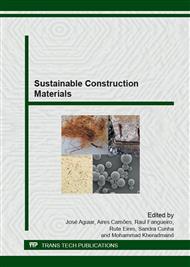p.357
p.367
p.379
p.389
p.400
p.410
p.421
p.433
p.447
A Study of the Nature of the Shear Strength of Soil-Waste Composites
Abstract:
The soil is a brittle material compared to other engineering materials such as steel, concrete and wood. The clayey nature of the soils of western Paraná causes them to be chemically reactive towards certain compounds, thereby improving their engineering properties, especially its mechanical strength. The study involved treating the typical soil of the region with two residues from industrial and human activities: rice husk ash (RHA) at doses 0; 2.5; 5; 7.5 and 10%; and burned sewage sludge (BSS) at doses 0; 5; 10; 15 to 20%; in the dry soil mass. The test samples were compacted in Mini-MCV equipment and broken in triaxial compression tests of consolidated undrained type, with confining pressures of 25; 50 and 100 kPa. The results showed that both the RHA change dramatically as the BSS which passes viscoelastic plastic-linear mechanical behavior of the composites. There was a significant increase in deviator tension and elasticity modulus, implying a gain in strength and stiffness of the composite compared to the natural soil. The most striking effect was observed in the RHA cohesion parameter; while the substantial effect of BSS was observed in the interparticles friction angle. These results suggest that RHA promoted the formation of new products filling the pore space of the composite, changing the clayey material in a nature of a continuum, while the BSS promoted a substantial aggregation of the particles, wherein the soil reinforcement transformed clay in a particulate material coarser grain size.
Info:
Periodical:
Pages:
400-409
Citation:
Online since:
December 2014
Keywords:
Price:
Сopyright:
© 2015 Trans Tech Publications Ltd. All Rights Reserved
Share:
Citation:


